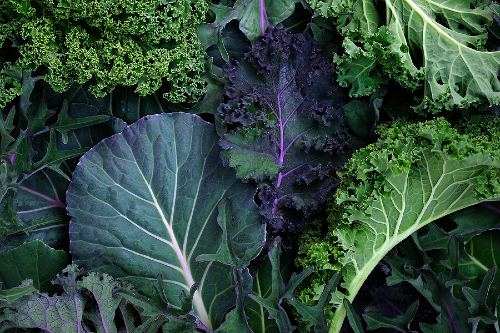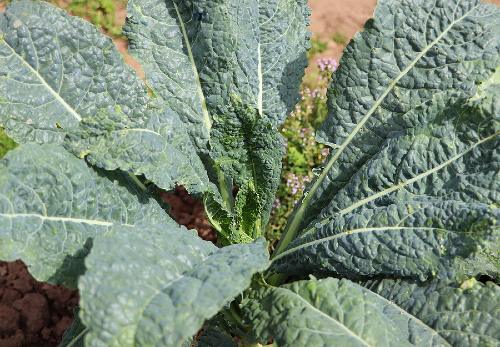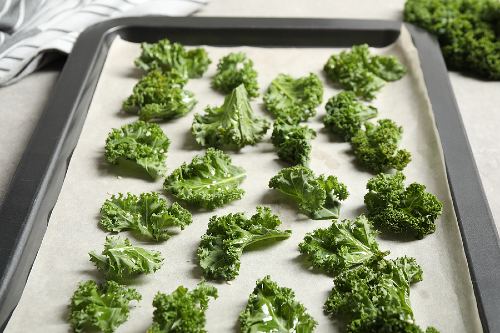The next featured vegetable in our “What’s in Season?” series is kale!
What sets kale apart?
Kale is a dark green vegetable that can be used in so many different dishes. Most of us have heard of kale and have probably tried it a few times. It seems to be on almost every restaurant menu! But do you know why kale is so popular? Here are some of our favorite facts about this leafy vegetable:
- Kale is low in calories but high in important vitamins and minerals. One of these minerals is calcium which is important for building and keeping strong bones. [1] Learn more about how calcium, bones, and aging by clicking on this link.
- Dark green vegetables like kale are full of antioxidants like Vitamin C. [2] Vitamin C is important for supporting your immune system and fighting off disease. [3]
- Kale is also high in iron. Our bodies need iron for healthy blood cells. Iron is also what makes our blood red! [4]
- Did you know that kale is actually a type of cabbage? It grows differently than other cabbage plants in that it does not form a head. [5]

Harvested in Georgia
When you should plant kale is dependent on where you live in Georgia. If you live in the northern part of the state, you should plant anytime between the months of March to August. If you live in South Georgia, it is better to plant between either August to October or February to April. [6]
Kale is typically harvested in the winter months of October through December and again in the spring from March to May. As kale leaves grow, they curl around the edges. [6] Leaves should be picked from the plant when they are tender. Try not to pick those with tough stems. [6] To learn more about planting and maintaining kale in your home garden, check out this UGA Cooperative Extension Service resource.
If you don’t have a home garden but still want local produce, like kale, you can find Georgia growers by clicking on this link . And check out our What’s in Season chart to keep track of when you can expect other local fruit and vegetables to be available!
Now that you have your fresh produce, it’s important to know how to store it. Fresh kale can be safely stored in a plastic bag in the refrigerator. [5] Like other leafy greens, kale has a shelf life of around two weeks. [6] Before using kale, make sure to wash the leaves under running water and get rid of any discolored leaves. [5]
Finally: eat your harvest! Check out the next section for some of our favorite kale recipes.

Kale Recipes
- Breakfast time is a great opportunity to add an extra serving of vegetables to your diet. Try this recipe for Egg, Kale, and Sweet Potato Breakfast Casserole. You can substitute other leafy greens like spinach for the kale or use regular potatoes instead of sweet potatoes. The choices are endless!
- Try one of these kale salad recipes for a light and refreshing lunch: Kale and Orange Salad or Harvest Kale Salad
- Fall is coming fast, and everyone enjoys a warm bowl of soup. This recipe for Savory Pork and Kale Soup is a must-try. If you want vegetarian options, try our Slow-Cooker West African Peanut Stew or Crockpot Vegetable Lentil Stew. Depending on the recipe, you can substitute kale for other leafy greens like collard greens, spinach, mustard greens, or turnip greens. Note: If you are substituting a thicker leafy green (ex. collards) for a thinner green like kale, it is best to add the greens a little earlier in than the original recipe states. This is because greens that are thicker in texture will require more time to cook until tender.
- Looking for a quick way to use up the leftover kale in your fridge? Rinse kale under running water, pat dry, and chop or tear the leaves into 2-inch pieces. Lightly coat with olive oil, and sprinkle with salt, pepper, and your favorite spices. Scatter the kale on a baking sheet and pop them in a 300°F oven until they are dry and crunchy. Enjoy!

Whether you grow it in your backyard, buy it from a local grower, or purchase it at the grocery store, we hope this blog has shown you just how special kale is and that there can be a place for it in your diet.
Check back next month for the next featured Georgia-grown fruit or vegetable.
Written by Darci Bell, RDN, LD | Edited by Leslie Davis, RDN, LD, CDCES, and the Nutrition Team
Posted: October 10, 2022
[2] University of Kentucky College of Agriculture
[4] Harvard T.H. Chan School of Public Health